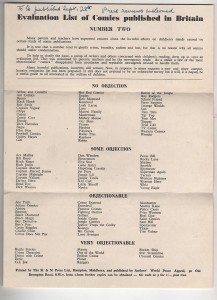 Found among a pile of literary ephemera at Jot HQ is this single sheet folded twice and entitled ‘ Comics Evaluation List Number Two ‘. According to a handwritten inscription at the head of the text this was evidently a proof of a document to be published, probably in September 1953. In 1952, in the words of the introduction ‘ a group of writers and others concerned with children’s reading’ had drawn up a list of comics that glorified ‘ crime, brutality, sadism and lust ‘. As a result of this first ‘ evaluation list ‘ some of these publications had ‘disappeared from circulation and reputable newsagents refused to handle them’.
Found among a pile of literary ephemera at Jot HQ is this single sheet folded twice and entitled ‘ Comics Evaluation List Number Two ‘. According to a handwritten inscription at the head of the text this was evidently a proof of a document to be published, probably in September 1953. In 1952, in the words of the introduction ‘ a group of writers and others concerned with children’s reading’ had drawn up a list of comics that glorified ‘ crime, brutality, sadism and lust ‘. As a result of this first ‘ evaluation list ‘ some of these publications had ‘disappeared from circulation and reputable newsagents refused to handle them’.
This second list was to be a more extensive catalogue of offensive publications that nonetheless included those comics to which the board of censors had no objection. If we look at the publication details on the bottom of the list we find that it was printed for the ‘Authors’ World Peace Appeal’. Further investigation reveals that this was a British pacifist organisation launched in October 1951 which flourished in the immediate post-war period of Cold War incriminations where the horrors of the Holocaust and of Hiroshima and Nagasaki were still fresh in the public mind. In their Bulletin number 7 (n.d.) the writers mentioned in the Comics list expressed their views thus:-
‘We writers believe that our civilisation is unlikely to survive another world war. We believe that differing political and economic systems can exist side by side on the basis of peacefully negotiated settlements . As writers we want peace and through our work will try and get it, and we pledge ourselves to encourage an international settlement through peaceful negotiations . We condemn writing liable to sharpen existing dangers and hatred. As signatories we are associated with no political movement, party, or religious belief, but are solely concerned with trying to stop the drift to war,’
Some of the names of the signatories to this declaration are printed. The writers included:
Edmund Blunden, Vera Brittain, Albert Camus, Alex Comfort, Rupert Croft Cooke ( see earlier Jot), A.E.Coppard, Christopher Fry, William Gerhardi, Joyce Grenfell, Aldous Huxley, C.E.M.Joad, Marghanita Laski, Doris Lessing, C.Day Lewis, Compton Mackenzie, Naomi Mitchison, Sean O’ Casey, Kathleen Raine, Herbert Read, Siegfried Sassoon, Edith Sitwell, Dylan Thomas, Sylvia Townsend Warner. Continue reading



